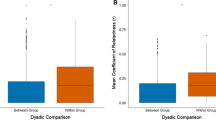Abstract
We investigated the presence of kin-biased cooperative breeding in the Common Eider (Somateria m. mollissima), a colonial seaduck commonly presumed to have a high rate of natal philopatry. Based on a 23-year-long time series of individually marked mothers and daughters, we found that on average 18% of the study population consisted of first-order relatives: mothers, daughters, and female siblings. However, there were years with no or only a few first-order kin pairs present. This was due to the overall low duckling survival in this species and the high rate of natal dispersal in this population. There was no apparent tendency for timely nesting relatives (laying within 3 days of each other) to approach each other, indicating no firm kin recognition. In a 3-year sampling of DNA from egg shell membranes, the annual rate of intraspecific brood parasitism in the population varied between 25 and 67%. However, becoming parasitized had no effect on the subsequent choice of brood tending tactics, i.e., whether to tend alone or communally. Neither was the choice of brood tending tactics affected by the number of own eggs in the clutch or by the female body condition. However, becoming a communal brood-tender was jointly contributed by the presence of alien eggs in the nest and the presence of first-order kin in the colony during early breeding. The greatest effect on females favoring communal brood care instead of rearing alone was due to the number of similar-aged broods nearby at the time of nest exodus. We found no evidence of firm kin recognition among individuals in our study population.
Zusammenfassung
Verwandtschaftsstruktur und Brutpflegetaktik in einer Population der Europäischen Eiderente ( Somateria m. mollissima )
Wir haben das Auftreten von verwandtschaftsbasiertem kooperativem Brüten bei der Europäischen Eiderente (Somateria m. mollissima) untersucht, einer koloniebrütenden Meerente, bei der im Allgemeinen eine ausgeprägte Geburtsortstreue angenommen wird. Basierend auf einer 23 Jahre währenden Zeitreihe individuell markierter Mütter und Töchter fanden wir, dass durchschnittlich 18% der untersuchten Population aus Verwandten ersten Grades bestanden: Müttern, Töchtern und Schwestern. Es gab jedoch Jahre, in denen nur wenige Verwandtschaftspaare ersten Grades anwesend waren. Dies war auf die insgesamt niedrige Überlebensrate der Entenküken bei dieser Art und die hohe Rate der Abwanderung vom Geburtsort in dieser Population zurückzuführen. Verwandte, die innerhalb von drei Tagen mit der Eiablage begannen, zeigten keine offensichtliche Tendenz, sich einander zu nähern, was darauf hindeutet, dass Verwandte nicht sicher erkannt werden. Die Entnahme von DNA-Proben aus der Eischalenmembran über einen Zeitraum von drei Jahren zeigte, dass die jährliche Rate von intraspezifischem Brutparasitismus in der Population zwischen 25 und 67% variierte. Ob ein Nest parasitiert wurde oder nicht, hatte jedoch keinen Einfluss darauf, ob Brutpflege anschließend allein oder gemeinsam betrieben wurde. Die Wahl der Brutpflegetaktik wurde auch nicht durch die Anzahl der eigenen Eier im Gelege oder die Körperkondition des Weibchens beeinflusst. Das Vorhandensein fremder Eier im Nest in Kombination mit der Anwesenheit von Verwandten ersten Grades in der Kolonie während der frühen Brutphase trug jedoch zum Auftreten gemeinschaftlicher Brutpflege bei. Die Anzahl der Bruten ähnlichen Alters in der Nähe zum Zeitpunkt des Verlassens des Nests begünstigte jedoch am stärksten das Auftreten gemeinschaftlicher Brutpflege. Wir fanden keine Hinweise darauf, dass die Individuen in der untersuchten Population Verwandte sicher erkennen konnten.




Similar content being viewed by others
References
Anderholm S, Marshall RC, van der Jeugd HP, Waldeck P, Larsson K, Andersson M (2009a) Nest parasitism in the barnacle goose: evidence from protein fingerprinting and microsatellites. Anim Behav 78:167–174
Anderholm S, Waldeck P, van der Jeugd HP, Marshall RC, Larsson K, Andersson M (2009b) Colony kin structure and host-parasite relatedness in the barnacle goose. Mol Ecol 18:4955–4963
Andersson M, Åhlund M (2000) Host-parasite relatedness shown by protein fingerprinting in a brood parasitic bird. Proc Natl Acad Sci USA 97:13188–13193
Andersson M, Waldeck P (2006) Reproductive tactics under severe egg predation: an eider’s dilemma. Oecologia 148:350–355
Andersson M, Waldeck P (2007) Host-parasite kinship in a female-philopatric bird population: evidence from relatedness trend analysis. Mol Ecol 16:2797–2806
Bjørn TH, Erikstad KE (1994) Patterns of intraspecific nest parasitism in the high Arctic common eider (Somateria mollissima borealis). Can J Zool 72:1027–1034
Blums P, Mednis A, Nichols JD (1994) Retention of web tags and plasticine-filled leg bands applied to day-old ducklings. J Wildl Manag 58:76–81
Blums P, Davis JB, Stephens SE, Mednis A, Richardson DM (1999) Evaluation of plasticine-filled leg band for day-old ducklings. J Wildl Manag 63:656–663
Bolduc F, Guillemette M (2003) Incubation constancy and mass loss in the common eider Somateria mollissima. Ibis 145:329–332
Brown P, Zhou L (2010) MCMC for generalized linear mixed models with glmmBUGS. R J 2:13–17
Bustnes JO, Erikstad KE (1993) Site fidelity in breeding common eider Somateria mollissima females. Ornis Fenn 70:11–16
Eadie JM, Kehoe FP, Nudds TD (1988) Pre-hatch and post-hatch brood amalgamation in North American Anatidae: a review of hypothesis. Can J Zool 66:1709–1721
Erikstad KE, Tveraa T (1995) Does cost of incubation set limits to clutch size in common eiders Somateria mollissima. Oecologia 103:270–274
Fields RL, Scribner KT (1997) Isolation and characterization of novel waterfowl microsatellite loci: cross-species comparisons and research applications. Mol Ecol 6:199–202
Gibbons DW (1986) Brood parasitism and cooperative breeding in the moorhen, Gallinula chloropus. Behav Ecol Sociobiol 19:221–232
Hamilton WD (1987) Discriminating nepotism: expectable, common, overlooked. In: Fletcher DJC, Michener CD (eds) Kin recognition in animals. Wiley, Chichester, pp 417–438
Hanssen SA, Erikstad KE, Johnsen V, Bustnes JO (2003) Differential investment and costs during avian incubation determined by individual quality: an experimental study of the common eider (Somateria mollissima). Proc R Soc Lond B 270:531–537
Hario M, Rintala J (2006) Fledgling production and population trends in Finnish common eiders (Somateria m. mollissima)—evidence for density dependence. Can J Zool 84:1038–1046
Hario M, Rintala J (2009) Age of first breeding in the common Eider Somateria m. mollissima population in the northern Baltic Sea. Ornis Fenn 86:81–88
Hario M, Selin K (1988) Thirty-year trends in an eider population: timing of breeding, clutch size, and nest site preferences. Finn Game Res 45:3–10
Hollmén T (2002) Biomarkers of health and disease in common eiders (Somateria mollissima) in Finland. Dissertation, University of Helsinki
Hollmén T, Franson JC, Hario M, Sankari S, Kilpi M, Lindström K (2001) Use of serum biochemistry to evaluate nutritional status and health of incubating common eiders (Somateria mollissima) in Finland. Phys Biochem Zool 74:333–342
Hollmén T, Franson JC, Kilpi M, Docherty DE, Hansen WR, Hario M (2002) Isolation and characterization of a reovirus from common eiders (Somateria mollissima) from Finland. Avian Dis 46:478–484
Jaatinen K (2009) Cooperation and conflict in conspecific brood parasitism, an alternative reproductive tactics. Dissertation, University of Helsinki
Jaatinen K, Öst M (2011) Experience attracts: the role of age in the formation of cooperative brood-rearing coalitions in eiders. Anim Behav 81:1289–1294
Jaatinen K, Jaari S, O’Hara R, Öst M, Merilä J (2009) Relatedness and spatial proximity as determinants of host-parasite interactions in the brood parasitic Barrow’s goldeneye (Bucephala islandica). Mol Ecol 18:2713–2721
Jones O, Wang J (2009) COLONY: a program for parentage and sibship inference from multilocus genotype data. Mol Ecol Res 10:551–555
Komdeur J, Hatchwell BJ (1999) Kin recognition: function and mechanism in avian societies. Trends Ecol Evol 14:237–241
Kruger O, de Brooke Ml (2007) Brood parasitism in birds. In: Jamieson BGM (ed) Reproductive biology and phylogeny of birds. Science Publishers, Plymouth, pp 327–366
Laurila T, Hario M (1988) Environmental and genetic factors influencing clutch size, egg volume, date of laying and female weight in the common eider Somateria mollissima. Finn Game Res 45:19–30
Lehikoinen A, Kilpi M, Öst M (2006) Winter climate affects subsequent breeding success of common eiders. Glob Change Biol 12:1355–1365
Lehikoinen A, Öst M, Hollmén T, Kilpi M (2008) Does sex-specific duckling mortality contribute to male bias in adult common eiders? Condor 110:574–578
Lopez-Sepulcre A, Kokko H (2002) The role of kin recognition in the evolution of conspecific brood parasitism. Anim Behav 64:215–222
Lunn DJ, Thomas A, Best N, Spiegelhalter D (2000) WinBUGS—a Bayesian modelling framework: concepts, structure, and extensibility. Stat Comp 10:325–337
Lunn D, Spiegelhalter D, Thomas A, Best N (2009) The BUGS project: evolution, critique and future directions. Stat Med 2009:3049–3067
McKinnon L, Gilchrist HG, Scribner KT (2006) Genetic evidence for kin-based female social structure in common eiders (Somateria mollissima). Behav Ecol 17:614–621
McRae S, Burke T (1996) Intraspecific brood parasitism in the moorhen: parentage and parasite-host relationships determined by DNA fingerprinting. Behav Ecol Sociobiol 38:115–129
Milne H (1974) Breeding numbers and reproductive rates of eiders at the Sands of Forvie nature reserve, Scotland. Ibis 116:135–154
Öst M, Ydenberg R, Kilpi M, Lindström K (2003a) Condition and coalition formation by brood-rearing common eider females. Behav Ecol 14:311–317
Öst M, Ydenberg R, Lindström K, Kilpi M (2003b) Body condition and the grouping behavior of brood-caring female common eiders (Somateria mollissima). Behav Ecol Sociobiol 54:451–457
Öst M, Vitikainen E, Waldeck P, Sundström L, Lindström K, Hollmén T, Franson C, Kilpi M (2005) Eider females form non-kin brood-rearing coalitions. Mol Ecol 14:3903–3908
Paulus KB, Tiedemann R (2003) Ten polymorphic autosomal microsatellite loci for the eider duck Somateria mollissima and their cross-species applicability among waterfowl species (Anatidae). Mol Ecol Notes 3:250–252
Robertson GJ (1998) Egg adoption can explain joint egg-laying in common eiders. Behav Ecol Sociobiol 43:289–296
Ruusila V, Pöysä H, Runko P (2000) Characteristics of maternal family lineages in a common Goldeneye Bucephala clangula breeding population. Ornis Fenn 77:77–82
Sonsthagen SA, Talbot SL, Lanctot RB, McCracken KG (2010) Do common eiders nest in kin groups? Microgeographic genetic structure in a philopatric sea duck. Mol Ecol 19:647–657
Swennen C, Duiven P, Reyrink LAF (1979) Notes on the sex ratio in the common eider Somateria mollissima (L.). Ardea 67:54–61
Swennen C, Ursem JHC, Duiven P (1993) Determinate laying and egg attendance in common eiders. Ornis Scand 24:48–52
van der Jeugd HP, van der Veen IT, Larsson K (2002) Kin clustering in barnacle geese: familiarity or phenotype matching? Behav Ecol 13:786–790
Waldeck P, Andersson M (2006) Brood parasitism and nest takeover in common eiders. Ethology 112:616–624
Waldeck P, Kilpi M, Öst M, Andersson M (2004) Brood parasitism in a population of common eider (Somateria mollissima). Behaviour 141:725–739
Waldeck P, Andersson M, Kilpi M, Öst M (2008) Spatial relatedness and brood parasitism in a female-philopatric bird population. Behav Ecol 19:67–73
Wang J (2002) MER (V3) A program for estimating pairwise relatedness from genetic markers. http://zoo.cam.ac.uk/ioz/people/wang.htm Accessed 5 February 2009
Wang J (2004) Sibship reconstruction from genetic data with typing errors. Genetics 166:1963–1979
Zink AG (2000) The evolution of intraspecific brood parasitism in birds and insects. Am Nat 155:395–405
Acknowledgments
Our sincere thanks are due to all our co-workers at Söderskär, especially to Chris Franson, Tuula Hollmén, Jukka T. Lehtonen, Outi Ovaskainen, Karl Selin, Henri Selin, and Pertti Muuronen. We greatly acknowledge the laboratory research done by Marjatta Säisä and Tuire Pankasalo. Thoughtful comments on an earlier draft were provided by two anonymous reviewers. The language was checked by Roy Siddall. This research was carried out in compliance with the current laws of Finland and received permission from the Ministry of Environment and the Animal Care committee of the University of Helsinki.
Conflict of interest
The authors declare that they have no conflict of interest.
Author information
Authors and Affiliations
Corresponding author
Additional information
Communicated by P. H. Becker.
Rights and permissions
About this article
Cite this article
Hario, M., Koljonen, ML. & Rintala, J. Kin structure and choice of brood care in a Common Eider (Somateria m. mollissima) population. J Ornithol 153, 963–973 (2012). https://doi.org/10.1007/s10336-012-0825-3
Received:
Revised:
Accepted:
Published:
Issue Date:
DOI: https://doi.org/10.1007/s10336-012-0825-3




